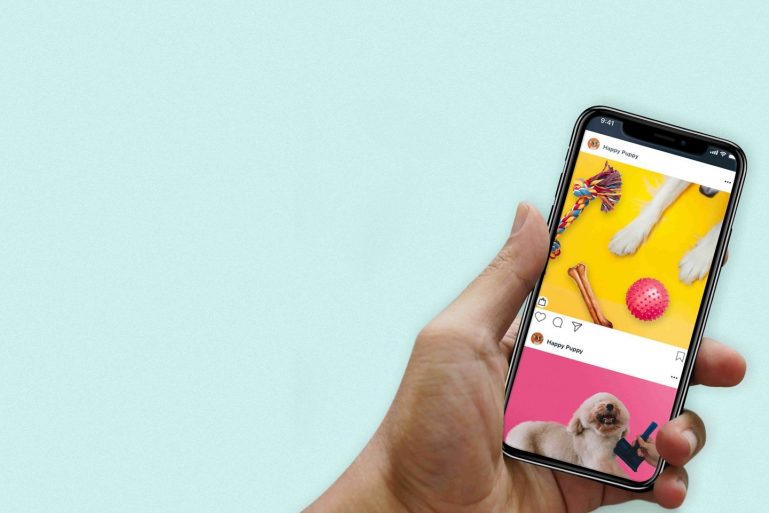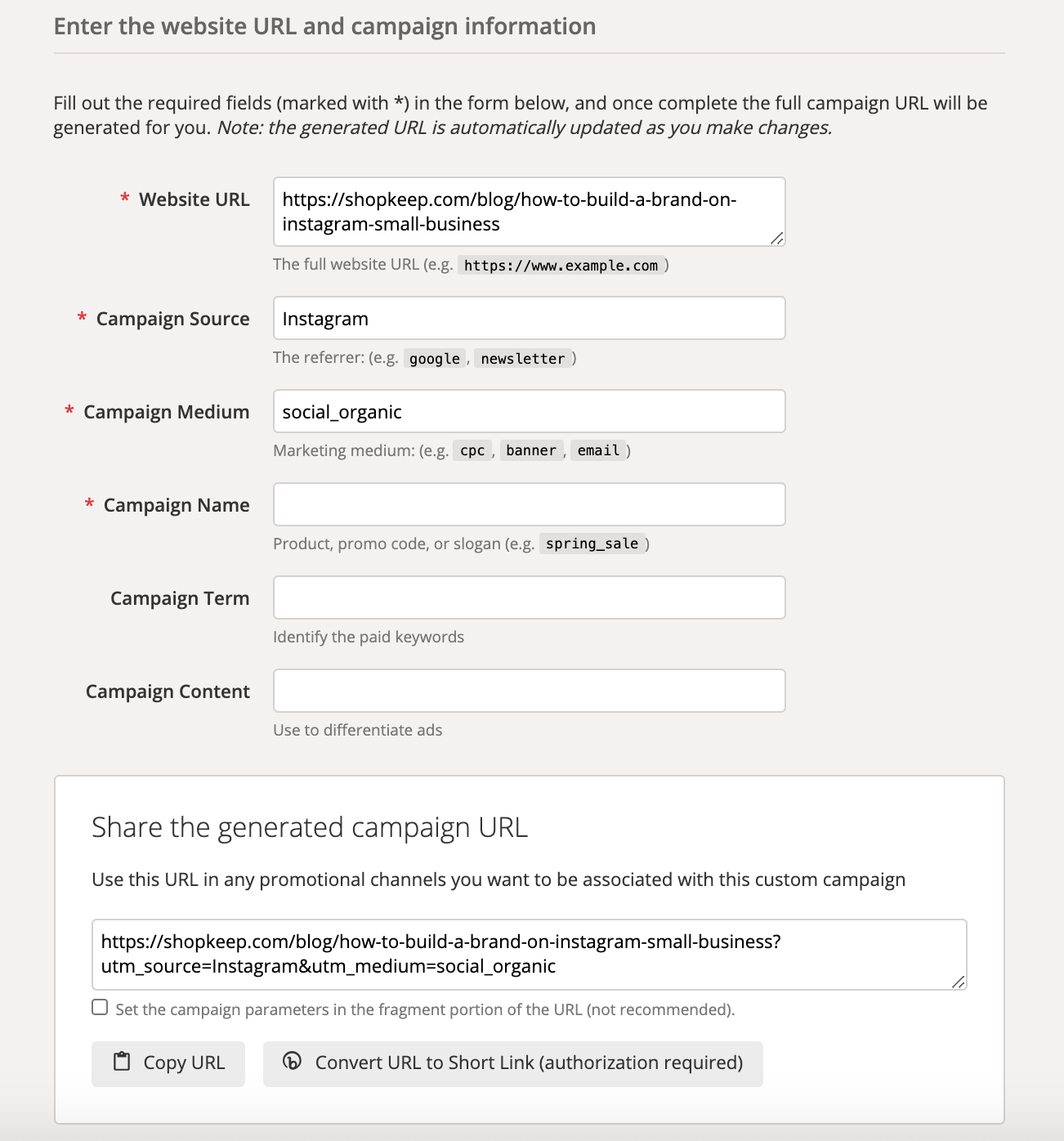
How to Build a Brand on Instagram for Your Small Business in 2021
Just like your website, social media is no longer an afterthought. With over 2.7 billion active users and counting, Instagram can expand your reach far beyond the walls of your business. While Instagram may be free to use, building a successful brand for your small business will take time and effort. By following these 11 Instagram branding tips, you’ll be well on your way to building a loyal community and creating a viable sales channel on Instagram in 2021 and beyond.
How to Build a Brand on Instagram for Your Small Business
- Define Your Goals for Instagram
- Pinpoint Your Content Pillars
- Create Cohesive Visual Assets
- Use Specific Sounds and Words as Branding Tools
- Build Out Your Content Calendar
- Post Consistently
- Conduct Hashtag Research
- Engage With Other Accounts and Your Audience
- Use Stories to Have a Dialogue With Your Audience
- Use Reels to Expand Your Reach
- Track Your Metrics and Adjust Your Strategies Over Time
1. Define Your Goals for Instagram
Your Instagram account is so much more than a bunch of squares. Before you can start creating engaging content and building a successful brand, ask yourself: what do you want your posts to accomplish? Are you looking to:
- Increase awareness for your business and get more customers in the door?
- Drive sales (both in store and on your website)?
- Connect with customers directly?
- Get more people to visit your website?
Instagram can help you do all of these things and more, but narrowing down which goals are the most important for your business will give you a better idea of what to post.
2. Pinpoint Your Content Pillars
Once you’ve defined your goals, you’ll need to think creatively about how your content will help you achieve them. You can use a set of “Content Pillars” or defined topics to come up with different ideas on what to feature. Here are some great thought-starters:
- What are the top 10 questions people ask you about your small business? Create a series to answer them.
- What’s a topic you could talk about for 30 minutes or more? Create a series where you discuss what you’re passionate about.
- What are your most popular products or orders? Create content that highlights your top sellers and what makes them so great.
- What does your business care about? Create content that lets your audience know that you care about certain issues and why those issues matter.
For every post you create, make sure there is a clear call-to-action, or set of instructions on what your audience should do after seeing the post. For content about your products, the call-to-action should be to shop the products, either through the post directly or via the link in your bio to your website. If your goal is to increase online orders, tell your customers that they can visit the link in your bio to place an order for delivery or pickup.
SEE ALSO: How to Transition from Brick-and-Mortar to an Online Store
3. Create Cohesive Visual Assets
This is the fun part! Now that you know what you want to talk about, it’s time to snap some photos and videos. These days, you don’t even need a fancy camera — your iPhone or Android can most likely get the job done. Similarly, you don’t need to be a Photoshop pro or a graphic designer to create beautiful graphics. You can use Canva, a free design tool, to create beautiful templates for your Instagram feed and Stories. While you’re taking photos and designing graphics, keeping the following things in mind will have you well on your way to establishing a strong visual identity:
Color Schemes: You probably already have certain colors that you’re using in your logo or signs. These same colors should be reflected in your posts as well. Stick to a defined branded color palette for a strong visual identity.
Filters: Photo filters or Adobe Lightroom presets are fantastic tools for building a unified look on your Instagram feed. If you decide to use either, make sure you use the same ones so that all of your photos look like they belong together. Our favorite, easy-to-use photo editing apps are VSCO and Tezza.
Fonts: When it comes to building a brand through typeface, less is more. Pick no more than two fonts to use on your graphics. These should also align with any fonts you use within your store, cafe, or restaurant.
SEE ALSO: We Changed Our App Icons. Here’s Why
4. Use Specific Sounds and Words as Branding Tools
Did you know that most brands can’t be identified by sound? Now that video content has become increasingly popular thanks to Stories, IGTV, and Instagram’s newest feature, Reels, you have the unique opportunity to use sounds to build your brand on Instagram. You don’t need to write a full-on commercial jingle, but having a 2-3 second sound bite to kick off your video content will help create a strong brand identity in a way that most big brands can’t even do.
Likewise, using your Instagram captions to create a distinct personality is another piece of the puzzle. Is your brand funny and lighthearted or more serious? Make sure your word choices reflect your business’s values appropriately. To take things even further, use the specific names of your products and services in your content form a closer community. For food businesses, you can use the names of your most popular food and drinks in your captions and graphics, like In N Out has done below:
For clothing boutiques and other retail stores, mention the names of your popular items so that your audience can begin to identify them and talk about them as fluently as you can. Doing so will create a “shared language” between you and your followers, which is a powerful way to build your community online.
5. Build Out Your Content Calendar
You’ve made your content, so now it’s time to make a calendar. There are tons of free tools to help you do this, including Google Spreadsheets and other downloadable templates. We recommend scheduling at least 2 weeks worth of content in advance. While it’s great to get ahead, we also advise against going more than a few months out. If we’ve learned anything in 2020, it’s that things can change at a moment’s notice.
When building your Instagram content calendar, most of your content will be what’s called “evergreen,” which means it’s always relevant, no matter the date. You’ll want to take stock of the relevant holidays, seasons, and promotions you’re running, which will require you to prepare what’s known as “timely” content. Here at ShopKeep, we love using the National Day calendar to help us pinpoint relevant national days for our small business audience.
6. Post Consistently
Consistency is one of the biggest keys to growing your brand. Having a content calendar will help you stay on track and show up consistently. We recommend posting to your Instagram feed 3-5 times per week to start. For Stories, post no more than 10 Story slides a day. You can always post more often whenever you have the time and resources. The more you post, the more visibility your account will get through Instagram’s algorithm.
7. Conduct Hashtag Research
Yep, hashtags are still a thing and they’re still important, especially if you’re a smaller account. You can use up to 30 hashtags per post and we recommend using all 30, if possible.
Be purposeful with the hashtags that you include. By that we mean: don’t just throw in random tags that have nothing to do with your content or business. You should be using hashtags strategically to reach potential followers and customers aka people who would actually benefit from or be interested in your content. For a more in-depth read on hashtag strategies, check out this blog post from Later.
While the jury is still out on whether or not it’s better strategy-wise to put the hashtags in the caption or as a separate comment, we recommend putting your hashtags in a comment below your post to keep your captions shorter and less cluttered.
8. Engage With Other Accounts and Your Audience
Social media is a two-way street. Not only is engagement the key to building a lively community, you’ll see better metrics across the board when you interact with others. If you’re not sure who to engage with or how to engage, here are our Golden Rules of Engagement:
- Engage with your current followers/customers. If someone leaves a comment, don’t leave them hanging! Always respond back to anyone who leaves a thoughtful comment or asks a question about your brand. Try to respond as quickly as possible. Same goes for DMs — always remember to check your “Message Requests” to see if anyone tags you in a Story or asks a question.
- Engage with other businesses. Instagram is also a powerful networking tool, so use it to your advantage! These days, it’s all about collaboration over competition. By following and engaging with other businesses in your area or niche, you’ll build a highly visible camaraderie and rapport as well as make meaningful business connections.
- Search through relevant hashtags and locations and engage with people there. If you run a local clothing boutique, you can engage with people who are using hashtags that match the style of the clothes you sell. For example, if you sell edgier pieces, try engaging with people posting outfit photos under the hashtag #edgyfashion. In addition to searching hashtags, you can also find people who are local to your area by searching your town’s location under the “Places” tab and interacting with their posts.
- Leave comments on posts, react to Stories, and comment through DMs. Comments are the most public way to engage and boost your visibility — just ask @diaryofafitmommyofficial, whose commenting strategy garnered national attention. While reacting to Stories or sending DMs aren’t going to thrust you into the spotlight, they’re an extremely meaningful and personal way to have a conversation with your fans.
9. Use Stories to Have a Dialogue With Your Audience
Your Instagram feed is typically reserved for your best photos and videos, which leaves Stories to be a space for more exploration. Stories actually has some of the best tools for engagement on the entire platform. Here are some ideas on how to use Stories features to engage your audience:
- Use the questions sticker or polls sticker to ask your audience questions about the content they want to see or what products you should launch next.
- Use the countdown sticker to build hype around a new launch or event.
- Use the slider feature to let your audience tell you what they love and how much they love it.
- Use GIF stickers to add fun, eye catching, animated elements to your Stories. You can even design your own GIFs and make them into stickers and encourage your followers to use them in their posts.
10. Use Reels to Expand Your Reach
Fun fact: Instagram loves when you use their new features. In fact, using Reels might even give your account a boost over those who don’t use it. This could give your account an immense advantage over your competitors if they aren’t using Reels.
Reels are Instagram’s answer to TikTok, a video social media platform that skyrocketed in popularity in 2020. To upload a Reel, visit the area where you would normally post Instagram Stories, and hover over to “Reels.” There, you can create a new Reel using Instagram’s editing tools or upload an existing video from your camera roll. Reels can be up to 30 seconds long.
Reels are an excellent way to get featured on Instagram’s Explore page and expand your reach. While there is no “magic trick” to getting on the Explore page, with the launch of Reels, a huge portion of Explore is dedicated to showing Reels from accounts you follow. If you post a Reel, there is a good chance that your Reel will show up in the Reels space on Explore, giving your brand some crazy valuable social media real estate that seemed like a pipe dream just months ago.
11. Track Your Metrics and Adjust Your Strategies Over Time
After you’ve posted your content, take the time to go back and see how each post performed. This will help you understand what your audience loves to see from you so you can create even better content.
How to Track Engagement Metrics and Reach on Instagram
Use Instagram’s in-house tools to check the number of likes, comments, shares, and saves on each of your posts, as well as how many people they reached and how your content was discovered. Look at what’s resonating and try to pinpoint why. Did you post a hilarious meme that people sent to their friends? Did you make an infographic that had really useful information? Did you use certain hashtags to make the reach on your post explode? Take your learnings from each set of posts and apply them to the next set.
How to Track Web Traffic From Instagram
For measuring clicks or visits to your website, we recommend using a free tool like Bitly or Google Analytics. You can sign up for a free Bitly account to create shortened links for your Instagram bio. Bitly will tell you how many people click on each link you’ve created.
Even better, if you have Google Analytics set up for your website, you can use their free Campaign URL builder tool to track your traffic. For example, in the image below, we’ve put “Instagram” as the Campaign Source for our link in our bio. We also added “social_organic” as the Campaign Medium. This is so that our Data team can distinguish between traffic from our Instagram feed versus our Instagram ads (which we label as “social_paid”). If you don’t run any ads, you can leave the Campaign Medium field blank. Once you’ve created a link with this URL tool, you’ll be able to clearly see “Instagram” labeled as a traffic source on your Google Analytics Pages Report.
The Bottom Line
Keep in mind that what may work on Instagram one month might not work the next. Audiences and tastes change, as does Instagram’s algorithm. If you’re serious about building your Instagram brand and community, it’s important to stay informed on what the current algorithm boosts and favors to give your posts the best chance at success. We love reading The Later Blog and Social Media Today to stay up to date on general social media trends. If you’re looking to get more small business social media tips, download our free guide below and subscribe to our Small Business Newsletter by clicking “Subscribe to Our Blog” on the top right.
Want to try ShopKeep for yourself?
Just answer a few easy questions.
Need help finding the right point of sale?
Just complete the form. We’ll call you right back to explain how ShopKeep can work for you.
Hit the ground running.Sprinting, in fact!
Read our free, comprehensive guide, Small Business 101, to learn all you need to know about starting a thriving business.



